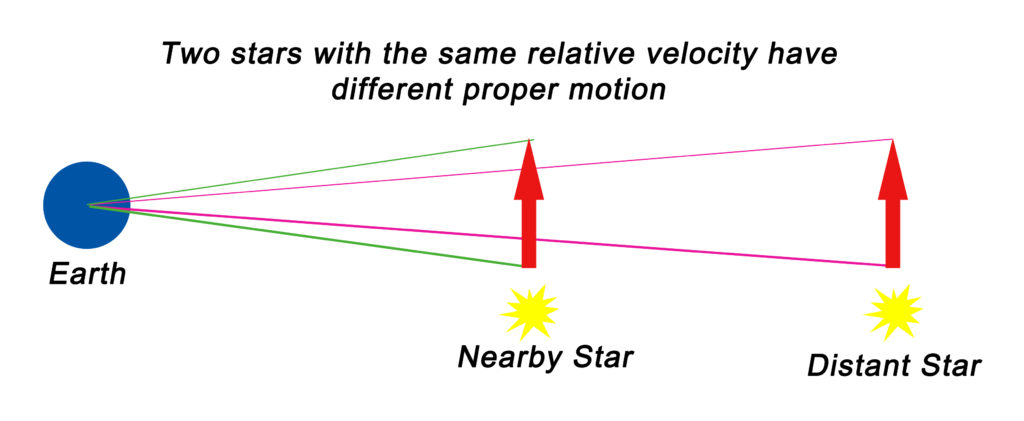Whenever I give a planetarium show to an audience, I always like to let time pass quickly. The stars appear to move, but I quickly point out that it is in fact the planet Earth turning that gives the stars their apparent motion through the night sky. I then reassure them that stars do move, it just takes a very long time for them to move a noticeable amount. Why is this?

The above animation of Barnard’s Star is a clue. Photographed once per year, Rick Johnson created this animation showing the movement of the small red dwarf. Barnard’s star is indeed small, but it is very close, only six light years away, making it the fourth closest star to the Sun. It is named after astronomer E. E. Barnard, who measured it’s proper motion in 1916, determining it to be greater than any known star. Proper motion is the apparent motion of a star relative to the apparently motionless background of more distant stars. The diagram below will help with the explanation.
Essentially, Barnard’s star appears to change position faster than any other star in the sky, partly because it is very close to us. More distant stars can move faster, but because they are so far away, this motion is very difficult to perceive.

Stars do move, but for most of the stars we can see in the sky, it takes a few millenia for us to notice their motion. Since human beings don’t live this long, the stars will stay in pretty much the same place during any person’s lifetime. If we could live much longer, we would see the stars slowly but surely move, and eventually all the constellations we see in the sky will look completely different.
So let’s enjoy the sky we have… future generations won’t see it exactly the way we do.

Comment* hi my name is Nathalie. I am very much curious about the stars. Almost every night i would look into the stars. And ive noticed that there are small stars moving slowly. To me that is so amazing, but m curiouse to know. Does this mean something? Your responce will be highly appreciated. Thax.
Hi Nathalie,
The universe is a pretty exciting place! The small stars that you notice moving slowly are very likely to be satellites orbiting the Earth hundreds of kilometers above you! They reflect sunlight and are most easily seen just after sunset. Stars in the night sky do move, and astronomers call this ‘proper motion.’ However, because the stars are very far away, their movement is incredibly slow, and it would take hundreds or thousands of years for humans on Earth to notice a change. This means that the stars in the sky are going to stay where they are relative to one another for our entire lifetimes. However, we can see different stars and constellations at different times of year because the Earth, with us on board, spins every 24 hours and orbits the Sun every 365.25 days.
To sum up, if something in the sky looks like it’s moving, it’s probably not a star, but something else, like a satellite, asteroid, comet, or meteor.
Thanks for your question!
Me and my mom saw a star slowly moving to us we got confused that if that’s a shooting star it would be fast to move but i searched it on google and I saw this and now I know the truth now.